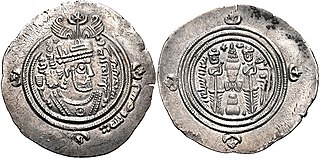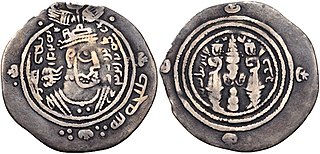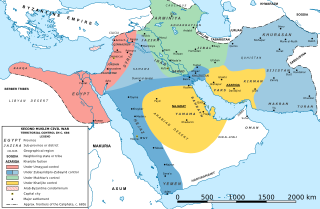Related Research Articles

Mu'awiya I was the founder and first caliph of the Umayyad Caliphate, ruling from 661 until his death. He became caliph less than thirty years after the death of the Islamic prophet Muhammad and immediately after the four Rashidun ('rightly-guided') caliphs. Unlike his predecessors, who had been close, early companions of Muhammad, Mu'awiya was a relatively late follower of Muhammad.

Yazid ibn Mu'awiya ibn Abi Sufyan, commonly known as Yazid I, was the second caliph of the Umayyad Caliphate, ruling from April 680 until his death in November 683. His appointment by his father Mu'awiya I was the first hereditary succession to the caliphate in Islamic history. His caliphate was marked by his campaign against of Muhammad's grandson Husayn ibn Ali at the massacre of Karbala that started the crisis known as the Second Fitna.

Marwan ibn al-Hakam ibn Abi al-As ibn Umayya, commonly known as Marwan I, was the fourth Umayyad caliph, ruling for less than a year in 684–685. He founded the Marwanid ruling house of the Umayyad dynasty, which replaced the Sufyanid house after its collapse in the Second Fitna and remained in power until 750.

Ubayd Allah ibn Ziyad was the Umayyad governor of Basra, Kufa and Khurasan during the reigns of caliphs Mu'awiya I and Yazid I, and the leading general of the Umayyad army under caliphs Marwan I and Abd al-Malik.

Abu al-Mughira Ziyad ibn Abihi, also known as Ziyad ibn Abi Sufyan, was an administrator and statesman of the successive Rashidun and Umayyad caliphates in the mid-7th century. He served as the governor of Basra in 665–670 and ultimately the first governor of Iraq and practical viceroy of the eastern Caliphate between 670 and his death.

Abd Allah ibn al-Zubayr ibn al-Awwam was the leader of a caliphate based in Mecca that rivaled the Umayyads from 683 until his death.

The Second Fitna was a period of general political and military disorder and civil war in the Islamic community during the early Umayyad Caliphate. It followed the death of the first Umayyad caliph Mu'awiya I in 680, and lasted for about twelve years. The war involved the suppression of two challenges to the Umayyad dynasty, the first by Husayn ibn Ali, as well as his supporters including Sulayman ibn Surad and Mukhtar al-Thaqafi who rallied for his revenge in Iraq, and the second by Abd Allah ibn al-Zubayr.
Abu Uthman Amr ibn Uthman ibn Affan al-Umawi was a son of Caliph Uthman and played political and military roles during the caliphates of Mu'awiya I, Yazid I and Marwan I.
The Umayyad dynasty or Umayyads was an Arab clan within the Quraysh tribe who were the ruling family of the Caliphate between 661 and 750 and later of al-Andalus between 756 and 1031. In the pre-Islamic period, they were a prominent clan of the Meccan tribe of Quraysh, descended from Umayya ibn Abd Shams. Despite staunch opposition to the Islamic prophet Muhammad, the Umayyads embraced Islam before the former's death in 632. Uthman, an early companion of Muhammad from the Umayyad clan, was the third Rashidun caliph, ruling in 644–656, while other members held various governorships. One of these governors, Mu'awiya I of Syria, opposed Caliph Ali in the First Muslim Civil War (656–661) and afterward founded the Umayyad Caliphate with its capital in Damascus. This marked the beginning of the Umayyad dynasty, the first hereditary dynasty in the history of Islam, and the only one to rule over the entire Islamic world of its time.

ʿAbd Allāh ibn Khāzim al-Sulamī was the Umayyad governor of Khurasan between 662 and 665 and again in late 683, before becoming the nominal Zubayrid governor of the same province between 684 and his death.

Abū Ḥarb Salm ibn Ziyād ibn Abīhi was a general and statesman of the Umayyad Caliphate, who later defected to the caliphate of Abd Allah ibn al-Zubayr during the Second Muslim Civil War before returning to the Umayyads' ranks. Salm was appointed by Caliph Yazid I as the governor of Khurasan and Sijistan in 681. During the course of his governorship, he launched several expeditionary raids into the Central Asian regions of Transoxiana, including Samarkand, and Khwarazm. His successes and generous distribution of war booty among his Khurasani Arab troops gained him wide popularity with them, but after Yazid died, Salm was not able to maintain their loyalty to the Umayyads for long. After his troops and chosen successor, Abd Allah ibn Khazim al-Sulami, gave their allegiance to the rival caliphate of Abd Allah ibn al-Zubayr, Salm made for Basra. There, he ultimately joined Ibn al-Zubayr's camp, but was imprisoned in Mecca by the latter nonetheless. After paying a large bribe, he was released and following Ibn al-Zubayr's death at the hands of the Umayyads in late 692, he was reappointed the governor of Khurasan. However, he died before he could resume his duties.
Abdallah ibn Khalid ibn Asid was a member of the Umayyad dynasty and governor of Kufa in 673–675 during the reign of Caliph Mu'awiya I.
Mudrik ibn al-Muhallab ibn Abī Ṣufra was an Arab commander of the Umayyad Caliphate during the reigns of caliphs Abd al-Malik and Sulayman. During the nine-month-long governorship of his brother al-Mufaddal over Khurasan, Mudrik, who was headquartered in Balkh, was appointed alongside Uthman ibn Mas'ud as joint commander of an expedition against the rebel general Musa ibn Abd Allah ibn Khazim of Tirmidh. Mudrik was assigned to ensure the loyalty of Uthman and his largely Tamimi troops, due to his previous maltreatment by al-Mufaddal's father and brother, al-Muhallab ibn Abi Sufra and Yazid, respectively. Mudrik and Uthman secured alliances with the non-Muslim principalities surrounding Tirmidh and defeated Musa's forces, a task which had eluded many of al-Mufaddal's predecessors. After Musa was killed on the battlefield, his nephew Nadr ibn Sulayman ibn Abd Allah agreed to surrender Tirmidh only to Mudrik, not Uthman and the former allowed him to leave the fortress unharmed. The Muhallabids, the family to which Mudrik belonged, were dismissed and harassed by al-Hajjaj ibn Yusuf during the reign of Caliph al-Walid I, but with the accession of the latter's brother, Caliph Sulayman, in 715, the family's fortunes were revived. Yazid ibn al-Muhallab was made governor over Iraq, Khurasan and the eastern half of the Caliphate and appointed Mudrik as his first lieutenant governor over Sijistan (Sistan). He was later replaced by Yazid's son Mu'awiya.
Al-Walīd ibn ʿUtba ibn Abī Sufyān was an Umayyad ruling family member and statesman during the reigns of the Umayyad caliphs Mu'awiya I and Yazid I. He served two stints as the governor of Medina in 677/78–680 and 681–682. He was dismissed during his first term for failing to secure oaths of allegiance from Husayn ibn Ali and other senior Muslim figures who opposed Yazid's accession. After his relocation to Damascus during the Second Fitna, he was imprisoned in 684 for proclaiming his support for continued Umayyad rule and condemning the anti-Umayyad caliph Abd Allah ibn al-Zubayr. He was freed shortly after by his kinsman Khalid ibn Yazid and the pro-Umayyad Banu Kalb tribe.
Busr ibn Abi Artat al-Amiri was a prominent Arab commander in the service of Mu'awiya I, the governor of Islamic Syria (640s–661) and the first Umayyad caliph (661–680). A veteran of the early Muslim conquests in Syria and North Africa, Busr became an ardent partisan of Mu'awiya against Caliph Ali during the First Muslim Civil War. He led a large-scale campaign against Ali's supporters in Arabia, gaining the submission of Medina, Mecca and Ta'if to Mu'awiya's caliphate and carrying out punitive measures against the inhabitants of Yemen. His actions in Arabia, which included executing two young sons of Ali's cousin, the governor of Yemen Ubayd Allah ibn Abbas, and taking captive women from the Muslim tribe of Hamdan, were condemned as unprecedented atrocities by the traditional Muslim sources, particularly Shia Muslim writers.
Qays ibn al-Haytham al-Sulamī was an Arab commander and administrator in the service of the Rashidun, Umayyad and Zubayrid caliphates. Under the caliphs Uthman and Mu'awiya I he served at time as the sub-governor of Khurasan and the cities of Nishapur and Marw al-Rudh. He was from a prominent Arab family in Basra and was a leader among the tribal nobility of that city until his death after 684.
ʿAbd Allāh ibn Yazīd ibn Muʿāwiya ibn Abī Sufyān, commonly known as al-Uswār, was an Umayyad prince from the Sufyanid line of the dynasty. He was the son of Caliph Yazid I. After the death of his brother, Caliph Mu'awiya II, in 684, he and his brother, Khalid ibn Yazid, were deemed too young to succeed by the pro-Umayyad tribes of Syria and Umayyad rule was vested in the line of a distant kinsman, Marwan I. Abd Allah was a famed archer and horseman and commanded part of the army which took over Iraq from anti-Umayyad forces during the Second Fitna in 691.
Aslam ibn Zurʿa ibn ʿAmr ibn Khuwaylid al-Ṣāʿiq al-Kilābī was a prominent Arab chieftain of the Qays tribal faction in Basra and Khurasan and served as the governor of Khurasan in 675 and 677–679. In the period between his two terms, he continued to wield significant influence in the province alongside the governor Sa'id ibn Uthman. Unlike his predecessors and many of his successors, Aslam did not undertake further conquests from the Khurasan frontier into Transoxiana. Regarding possession of war booty and tribute, he consistently defended the interests of the Arab tribesmen in Khurasan, who made up the core of the Umayyad Caliphate's forces there and insisted on controlling the funds due to the high costs of their military activity, against the demands of the central government in Syria. Aslam was known to have imposed heavy taxation on the population of Khurasan. He was arrested by Qays ibn al-Haytham al-Sulami, who extracted from him 300,000 silver dirhams. Aslam was later dispatched to suppress a small Kharijite force in Ahwaz in 680/81, but was defeated. His son Sa'id and grandson Muslim also held high office.
Isḥāq ibn Ṭalḥa ibn ʿUbayd Allāh was a member of the Muslim elite settled in Iraq under Umayyad rule and a transmitter of Muslim tradition. The caliph Mu'awiya I appointed time oversee fiscal affairs in the vast province of Khurasan in 675 or 676, but he died on his way there. He was son of Talha ibn Ubaydallah and his sons and grandsons were transmitters of Muslim tradition in Medina and Kufa.
Al-Ḥārith ibn al-Ḥakam ibn Abī al-ʿĀṣ ibn Umayya was a senior adviser and cousin of Caliph Uthman. He played a role in the expedition against the Byzantines of North Africa in 647 and was later appointed supervisor of the market in the caliphal capital of Medina. A number of his descendants were active as estate holders and governors under their paternal kinsmen, the Umayyad caliphs, particularly the Marwanid house of al-Harith's brother Marwan I which ruled from 684 until 750.
References
- ↑ Ahmed 2010, pp. 111–112.
- ↑ Wellhausen 1927, p. 135.
- 1 2 3 4 5 6 Ahmed 2010, p. 112.
- ↑ Madelung 1997, p. 343, note 86.
- ↑ Madelung 1997, pp. 342–343.
- 1 2 3 4 5 6 Madelung 1997, p. 343.
- ↑ Madelung 1997, pp. 341–342.
- ↑ Ahmed 2010, p. 112, note 578.
- 1 2 3 Shaban 1979, p. 38.
- ↑ Shaban 1979, p. 37.
- ↑ Shaban 1979, pp. 37–38.
- ↑ Gibb 1923, pp. 19–20.
- 1 2 3 4 5 Gibb 1923, p. 20.
- ↑ Ahmed 2010, p. 113, note 583.
- 1 2 3 4 Ahmed 2010, p. 113.
- ↑ Madelung 2000, p. 333.